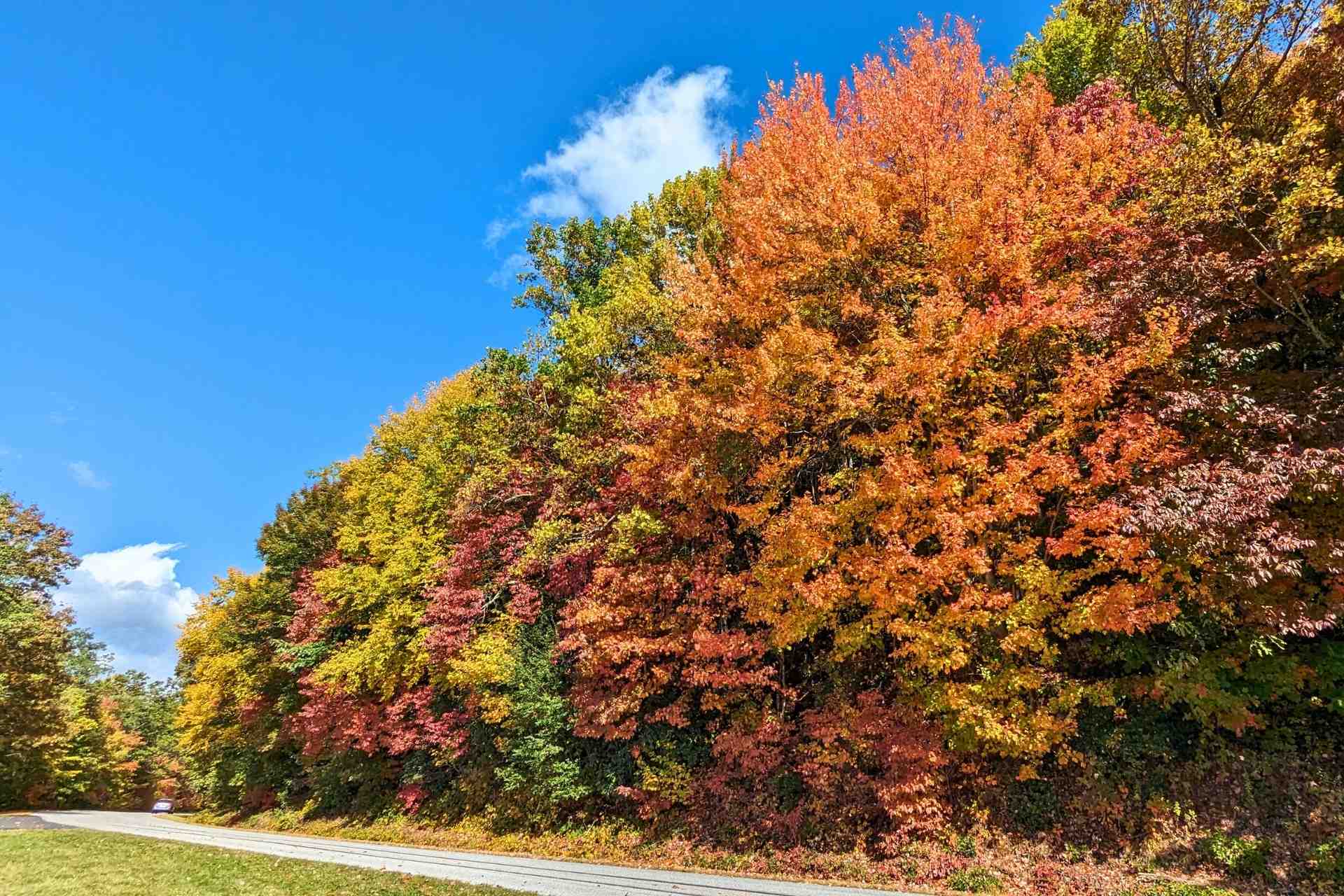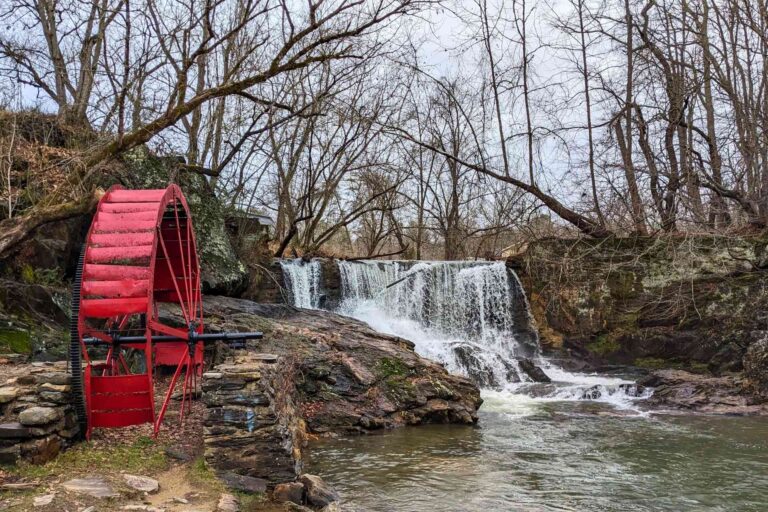What Fall is Like in Asheville: 5 Things to Know
When my husband and I moved to Western North Carolina in September 2022, we had no expectations about fall foliage. After living 15 years in Denver, Colorado we got pretty used to enjoying a couple of weeks of leaf-peeing vibrant aspen trees.
What is fall like in Asheville, North Carolina? It’s breathtakingly beautiful, unpredictable, and lasts much longer than you probably think. Keep reading for the five things you should know as you plan your trip to Western North Carolina.
1. What Fall is Like in Asheville: It’s Phenomenal
Fall in Asheville and Western North Carolina is like an explosion of colors every you look. Thanks to the Blue Ridge Mountains, you’ll be surrounded by changing species that turn a variety of different colors from red, crimson, orange, green, and purple.
Here are some of the color variations you can look forward to thanks to these tree species:
- Red leaves: Blackjack oak, Black oak, Red maple, Sassafras, Scarlet oak, Southern red oak, Sugar maples, Sweetgum, and Winged sumac all notably turn red during their peak fall foliage.
- Crimson leaves: Bradford pear, Dogwood, and Sourwood trees will turn a deep shade of red in the fall.
- Orange leaves: Sassafras, Silver maple, and White oak trees will turn to beautiful shades of orange.
- Yellow: American beech, American chestnut, American elm, American sycamore, Cottonwood, Ginkgo, Hickory, Tulip poplar, and Yellow birch trees will all turn a warm yellow shade during the fall season.
- Green leaves: Red spruce, Fraser fir, and Catawba rhododendron are evergreens that remain green yearlong. This provides a lovely calming color contrast to the fall colors.
- Purple leaves: Sassafras trees are a fascinating native species, which will turn from shades of red and orange to purple in the fall.

2. What Fall is Like in Asheville: It Lasts for Weeks
In my newbie naivety, I assumed that the leaves would last about two weeks. Thankfully, I was very wrong. Depending on the altitude of the trees, the colors will cascade down the mountains at different times – lasting for as long as six to seven weeks!
Fall foliage in Western North Carolina typically begins around the last week in September and can last through the second week of November. In downtown Asheville, the fall foliage is most likely to be at its liveliest during the last two weeks in October.
3. What Fall is Like in Asheville: It’s (un)predictable
There are several weather factors that can increase or decrease the speed and color intensity of fall foliage in Asheville and the surrounding Blue Ridge Mountains. Temperatures, sunshine, and wind all play a huge role in dictating when leaf-peeping begins and ends.
If you’re planning a trip in October or November, keep an eye on Asheville’s September forecasts. According to experts, weather conditions in September have the biggest impact on the fall season. So cross your fingers for warm, sunny days, cool nights, and light winds.
4. What Fall is Like in Asheville: There’s No Peak Day or Week
Elevation plays an enormous role in when leaves will begin to change in the fall. Trees and plants in higher mountain elevations (4,000-6,000 feet above sea level) will begin to change color the soonest thanks to colder temperatures. While trees and plants in lower elevations (2,000-3,000 feet) will roll into fall foliage after their higher-elevation friends.
The mountains and areas surrounding Asheville will peak at different times than Asheville and lower elevation areas. That means that there’s no specific peak day or week to see fall foliage in Western North Carolina. Instead, peak times will be based on the specific location you’re visiting.

5. What Fall is Like in Asheville: There Are Leaves Changing Somewhere
Visiting Asheville this fall from the end of September until early November? If the leaves haven’t started changing yet or they’ve already peaked in downtown Asheville take heart! Within an hour’s radius of downtown, you should still be able to see fall foliage thanks to changes in elevation. See things to know #4 for more details.
If you’re visiting Asheville and the leaves haven’t started changing yet, visit one of these areas located at higher elevations:
- Banner Elk
- Blowing Rock
- Boone
- Bryson City
- Cashiers
- Cherokee
- Great Smoky Mountains National Park
- Highlands
- Maggie Valley
- Mount Mitchell State Park
If you’re visiting Asheville and the leaves have already peaked downtown, visit one of these areas located at lower elevations:
- Hot Springs
- Lake Lure
- Marion
- Morganton
- Old Fort
Don’t Leaf Your Bucket List Hanging
The changing of seasons is a magical time in Western North Carolina. The variation of colors is mind-blowing, the steady and slow changes are inspiring and the number of places to go leaf-peeping will keep your travel itinerary jam-packed.
What questions do you have about fall in the Asheville area? Comment below. Is leaf peeping in Western North Carolina on your bucket list? Come visit and join me in trying something new!


![How Much It Costs to Visit the Biltmore Estate [2023 Guide]](https://trysomethingnewtuesday.com/wp-content/uploads/2023/09/how-much-it-costs-to-visit-the-biltmore-estate-768x512.jpg)

![When is Peak Fall Foliage in Asheville [2023 Predictions]](https://trysomethingnewtuesday.com/wp-content/uploads/2023/10/leaf-peeping-around-asheville-on-the-blue-ridge-parkway-768x512.jpg)


![Where to Stay in Black Mountain [2023 Lodging Guide]](https://trysomethingnewtuesday.com/wp-content/uploads/2023/10/where-to-stay-in-black-mountain-768x512.jpg)